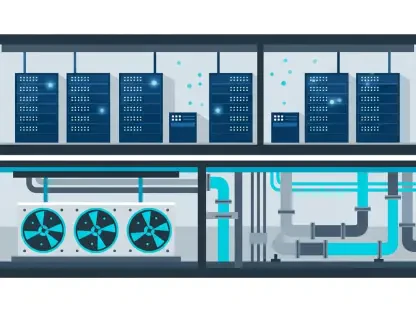In an era where digital transformation dictates the pace of business success, artificial intelligence (AI) stands out as a revolutionary force, particularly in the realm of enterprise networking. Far from being just another technological trend, AI is redefining how networks are built, managed, and secured, positioning them as the essential foundation for driving innovation and growth. The integration of AI into networking is not merely enhancing operational efficiency but also unlocking new avenues for competitive advantage. As businesses grapple with increasingly complex data demands, the role of AI in creating smarter, more adaptive networks becomes undeniable. This article explores the profound impact of AI on enterprise networking, shedding light on why modernizing infrastructure is a critical step for companies aiming to thrive in a data-driven landscape. From architectural shifts to strategic opportunities, the journey of AI networking reveals a path forward that no forward-thinking enterprise can afford to ignore.
Redefining Network Design with AI
The influence of AI on enterprise networking begins with a fundamental overhaul of network design, adapting to the unique demands of modern workloads. At the core, high-performance interconnects are indispensable for scaling GPU clusters that power AI training and inference tasks, ensuring that computational resources are utilized to their fullest potential. Meanwhile, front-end technologies such as Wi-Fi, private 5G, and edge networks play a pivotal role in gathering and channeling real-time data into AI models, enabling rapid decision-making. Across wide area networks (WAN), the emphasis on secure, low-latency connectivity ensures seamless data exchange between distributed locations and centralized AI data centers. This comprehensive redesign across multiple layers highlights how AI is not just an add-on but a transformative element that reimagines the very structure of enterprise connectivity, aligning it with the speed and scale required for today’s business environment.
Beyond structural changes, AI introduces a paradigm shift in how networks operate on a day-to-day basis, moving from static systems to dynamic, intelligent frameworks. The incorporation of generative, predictive, and agentic AI technologies allows networks to anticipate and address issues before they escalate, significantly reducing downtime and enhancing reliability. This proactive approach to management means that potential bottlenecks or security threats can be identified and mitigated in advance, creating a smoother user experience and freeing up IT teams to focus on strategic initiatives. Unlike traditional reactive models, where problems are fixed after they occur, AI-driven networks continuously learn and adapt, optimizing performance in real time. This evolution marks a critical turning point for enterprises, as it aligns network capabilities with the agility needed to support complex AI applications and maintain a competitive edge in a rapidly changing market.
The Urgent Need for Infrastructure Upgrades
As AI workloads continue to expand, the pressure on existing network infrastructure intensifies, revealing a stark reality for many enterprises. Research from Cisco indicates that an overwhelming 97% of IT networking executives recognize the necessity of infrastructure upgrades to effectively deploy AI solutions. Without such modernization, businesses risk facing slower innovation cycles, hampering their ability to respond to market shifts and customer demands. The stakes are high, as outdated systems struggle to handle the massive data volumes and processing speeds that AI applications require, leading to inefficiencies and lost opportunities. Upgrading isn’t merely a technical fix; it’s a strategic imperative that positions companies to leverage AI at scale, ensuring they remain agile and relevant in an increasingly competitive landscape where technology drives success.
Moreover, the push for modernization transcends mere hardware improvements, encompassing a broader rethink of network strategies to align with AI’s unique needs. Enterprises must consider not only the capacity of their systems but also the integration of advanced software tools that enable smarter traffic management and enhanced security protocols. The failure to adapt can result in significant setbacks, as competitors who invest in AI-ready infrastructure gain the upper hand through faster deployment of new services and improved operational efficiencies. Modern networks must be equipped to handle distributed environments, where data is processed at the edge as much as in centralized hubs, demanding a cohesive approach to upgrades. This holistic perspective on modernization underscores the urgency for businesses to act decisively, ensuring their networks are not just supportive but central to driving innovation in an AI-dominated era.
Industry Pioneers Shaping AI-Ready Solutions
Leading technology vendors are at the forefront of addressing the challenges posed by AI’s integration into networking, delivering solutions tailored for the future. Cisco, for instance, is spearheading advancements with tools like the Cisco AI Canvas, a specialized AI assistant designed to streamline network operations, alongside robust security enhancements and zero-trust frameworks to safeguard data integrity. These innovations reflect a commitment to creating networks that are not only powerful but also resilient against evolving threats. By focusing on agentic AI, which enables autonomous decision-making, Cisco is paving the way for systems that reduce human intervention while maximizing efficiency, setting a benchmark for what AI-driven networking can achieve in terms of performance and reliability for enterprises across various sectors.
In parallel, Hewlett Packard Enterprise (HPE), through its strategic acquisition of Juniper Networks, is crafting a comprehensive, end-to-end networking stack specifically optimized for AI workloads. This includes an AI-powered copilot integrated into the Aruba Networking EdgeConnect platform, which bolsters cybersecurity and supports proactive operational management. Such initiatives demonstrate a clear industry trend toward embedding AI capabilities directly into networking solutions, ensuring they can handle the complexities of modern data environments. The efforts of these industry giants are not isolated but part of a collective movement among tech leaders to redefine connectivity, making networks more adaptive and secure. Their work serves as a catalyst for broader adoption, encouraging businesses to rethink their infrastructure in light of AI’s transformative potential and the competitive advantages it offers.
Future Trends Shaping AI Networking
Looking to the horizon, several emerging trends are poised to define the trajectory of AI networking, offering a glimpse into how enterprises will manage data in the coming years. The widespread adoption of Ethernet in AI data centers stands out as a key development, providing the high-speed, reliable connectivity needed for intensive computational tasks. Simultaneously, the rollout of private 5G and Wi-Fi 7 technologies is set to revolutionize front-end data collection, enabling real-time processing at unprecedented speeds. Additionally, the prioritization of WAN traffic management ensures that critical data flows are handled efficiently across distributed networks. Together, these advancements support the creation of highly distributed environments where AI workloads can be processed closer to the source, reducing latency and enhancing overall system performance for businesses aiming to stay ahead.
Another significant trend is the growing emphasis on AI-driven operations to optimize network functionality, pushing beyond traditional management practices. By leveraging predictive analytics and autonomous systems, networks can dynamically adjust to changing conditions, ensuring optimal performance without constant oversight. This shift is particularly crucial as enterprises increasingly rely on edge computing, where data processing occurs at or near the point of generation, demanding robust connectivity solutions. Technologies like private 5G are gaining traction for their ability to meet these real-time requirements, while AI tools help in preemptively addressing potential disruptions. These trends collectively signal a future where networks are not just conduits of information but active participants in business strategy, enabling companies to harness AI’s full potential in delivering enhanced services and customer experiences.
Unlocking Strategic Value Through AI Networks
AI networking transcends technical necessity, emerging as a profound strategic opportunity for enterprises navigating a data-centric world. As businesses adopt edge computing and decentralized data processing to support AI applications, the role of advanced connectivity solutions becomes paramount. Technologies such as private 5G and Wi-Fi 7 are increasingly vital for managing real-time data flows, ensuring that information is processed swiftly and accurately across distributed environments. This capability is not just about speed but about enabling businesses to respond instantly to market changes and customer needs, thereby enhancing overall agility. The strategic value lies in transforming networks from passive infrastructure into active drivers of innovation, positioning them as a cornerstone for achieving long-term business goals in an era dominated by AI advancements.
Furthermore, the integration of AI-driven operations into networking offers enterprises a chance to redefine performance benchmarks and customer engagement standards. By optimizing network efficiency through predictive and autonomous systems, companies can minimize operational hiccups and deliver seamless experiences that build trust and loyalty among users. This goes hand in hand with the ability to scale AI initiatives rapidly, as modernized networks provide the bandwidth and reliability needed to support expansive data strategies. The convergence of these elements creates a powerful framework where networks directly contribute to business outcomes, from improved decision-making to innovative product offerings. Embracing AI networking thus becomes a pathway for enterprises to not only keep pace with technological shifts but to lead the charge in redefining industry standards and securing a sustainable competitive edge.
Reflecting on Transformative Milestones
Looking back, the journey of AI networking reveals a landscape where technology and business imperatives intertwine to create unprecedented opportunities. Enterprises that prioritized infrastructure upgrades witnessed a marked improvement in their ability to deploy AI solutions, outpacing competitors who hesitated to adapt. Industry leaders like Cisco and HPE, through strategic innovations and acquisitions, played a pivotal role in shaping solutions that addressed both technical and security challenges. Trends such as the adoption of Ethernet, private 5G, and AI-driven management redefined how networks supported distributed environments. Moving forward, businesses should focus on aligning their network strategies with these advancements, investing in scalable, secure systems to sustain growth. Exploring partnerships with technology vendors and staying abreast of emerging tools will be crucial steps in ensuring that networks remain a robust backbone for innovation in the AI era.









